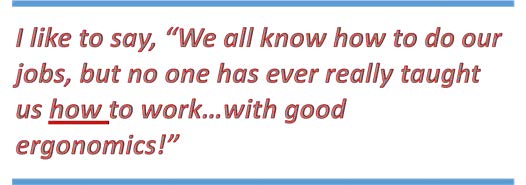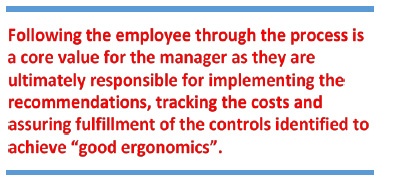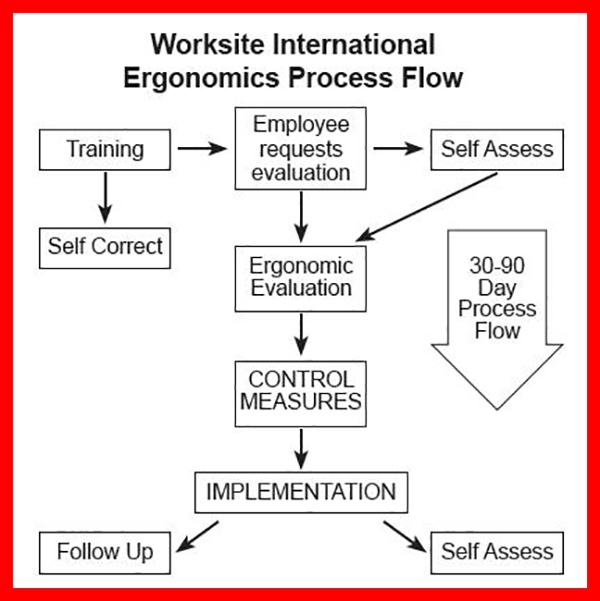
Developing, implementing and managing an ergonomics process (EP) is a worthwhile endeavor resulting in a positive and rewarding experience for all those involved. When properly constructed it engages and influences employees and management alike in an area that requires our undivided attention, our own health, wellness and safety. A successful ergonomics process will change the way the organization and those within operate on a day to day basis.
 Ergonomics is the study of how we work. It is a “human-centered” science integrating the tools and materials we handle, the tasks we perform and the environment we perform the work in. It is about the “goodness of fit”.
Ergonomics is the study of how we work. It is a “human-centered” science integrating the tools and materials we handle, the tasks we perform and the environment we perform the work in. It is about the “goodness of fit”.
Ergoprocess blogErgonomics is an art and a science. It is not necessarily intuitive to understand how we should work, for one must be taught how to be “more ergonomic”. Ergonomics is not common sense either.
For it to be, it must be commonly taught and commonly practiced. Ergonomics, at least for now, is neither of these. For this reason, organizations choosing to pursue an ergonomics process must do so with ample resources for long term dedication. For the process is about changing how we work and change takes time.
Employee’s Perspective:
For the employee, it is about learning how to work with more comfort, efficiency and effectiveness. It is essential that employees are given control through knowledge of workplace ergonomics. In simple terms, in the office ergonomics process, this means training employees on how to sit correctly and set up their workstation properly with good ergonomics.
To this end, the same applies to all modern day computer-based and office ergonomic tools. These include devices such as chairs, keyboard trays, keyboards and mice (standard or alternative), monitor enhancements such as risers or monitor arm mounts, document supports, footrests, telephone headsets and even height adjustable work surfaces. The use of these tools in today’s work place are essential to productive office operations and are an enhancement to each employee’s output. Never assume employees know or understand how to use these devices properly without effective instruction.The core values of the office ergonomics process for employees is to ensure:
• Each employee has the right tools,
• Understands how to use these tools correctly and
• Knows how to maximize the benefit of each at work by using safe work practices.
By doing so, the organization’s investment will pay off by minimizing employee work injury, maximizing productivity and ultimately improving employee job satisfaction.
Management’s Perspective:
From middle management’s perspective, the ergonomics process is about ensuring that each employee under their management has received awareness training on how to engage in the ergonomics process. Along with this, managers are ultimately responsible for ensuring employees have the right ergonomic tools to achieve maximum productivity at work. This is achieved through process engagement and using the services inherent to the ergonomics process to include:
1. Logging onto the online self-assessment (if available)
2. Undergoing a preventive evaluation when appropriate,
3. Becoming educated in safe work practices.

Managers are accountable to recognize the most appropriate time for an employee to enter into the process. This may be following a new hire to assure proper workstation set up; to prevent an injury from occurring or to manage an injury more effectively.
Routine communication with employees and dedication to the process flow including understanding how to correctly implement recommendations is vital to the employee’s success. To say that middle management is in a vulnerable position within the process is true, for this can often be seen as the “weakest link”. Never before have managers’ been expected to perform to this level of accountability. Yet, at the same time, managers can see themselves as the cornerstone of the process making the difference between success and failure in the ergonomics process flow.
Leadership Perspective:
From executive leadership’s perspective, choosing to embark on the ergonomics process must be based on a unanimous vision of driving change through ergonomics ultimately resulting in a healthier organization. This takes committed leadership along with the allocation of resources over an extended period of time until the ergonomics process is integral to all operations. For each, this could mean at least 3 years or longer before the process is truly “operationalized”.
Leadership must understand the ergonomics process is a dynamic part of continuous improvement and should be measured and altered as time goes on.
The most important message leadership can provide is the ongoing commitment of manpower and financial resources to support the startup and continuation of the ergonomics process.
A Worthwhile Investment:
Initial financial and time investments can be modest to substantial to roll out the EP tools and services, including identifying an appropriate online assessment tool, seeking out trainers and evaluators, and developing purchase criteria to select appropriate ergonomic furniture and accessories.
Once the process is in place, the return on investment will begin to show in numerous ways. Studies reveal an average return on investment (ROI) of $3.00 to $10.00 saved for every dollar invested. Additionally, employers can expect:
• Substantial claim avoidance
• Reduced absenteeism
• Decreased work injuries associated with poor ergonomics (CTD, RMI, CTS)
• Decreased claim costs
• Improved medical management and reduced severity of injuries.
Other benefits harder to measure but more significant than just dollars saved are
• Improved job satisfaction
• Better employee morale and engagement
• Improved productivity
• More efficient work processes and many other enhancements.

The EP can be used to influence change in employee work practices, management performance, facility planning, purchasing, work process flow and other internal processes resulting in essentially a “re-engineered” workplace, that at its core, truly values the individual worker as the most important asset of the organization.
A Lean System:
The EP is designed as a lean system with minimal waste and maximum value. Once operationalized, it will come full circle by enhancing employee experiences at work in more ways than just better workplace ergonomics. Suddenly, an employee’s needs are being met. For the most part, bias has been eliminated in discerning whether an employee’s needs are worth the investment. For the playing field has been leveled through an objective, measurable and meaningful process. This in turn, will result in a more fulfilling and committed work life within the organization and ongoing benefits at all levels for years to come.
To learn more about how to develop and manage a successful ergonomics process, read our outcome study using the Worksite International Ergonomics Process, presented internationally at the Nordic Ergonomics Society and the CDC’s conference on Total Worker Health in 2014.

Comments